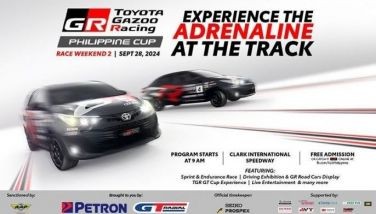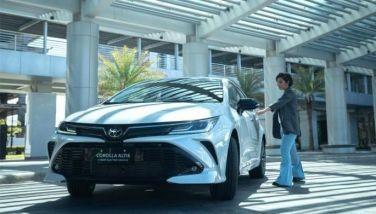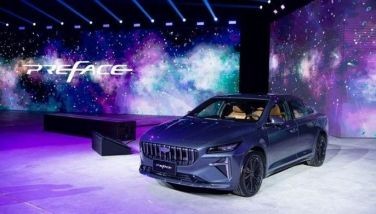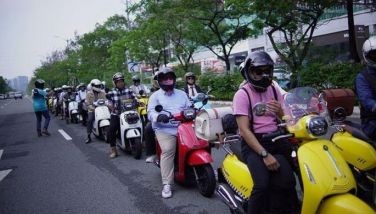Is the iBus a traffic cure-all?
MANILA, Philippines - Imagine a bus approaching a stop. It slows down and properly positions itself at the bay before its pneumatic doors swing open to unload passengers and take new ones in. After a short time, the doors close, and it accelerates out of the bay. Another bus takes its place, and the swift, orderly process continues. Commuters queue patiently at the stop, and do not venture out into the street to get a ride.
A work of naive fiction? Well, this utopian dream may be closer to realization than we think.
At least that’s what Elma Arboleras and Rodel De Guzman, inventors of the iBUS (Intelligent Bus Utility System), believe.
They consider themselves “novice inventors” (she wields a Customs Administration degree and an MBA; he has a Psychology degree) who merely applied themselves to the perennial problem that have beset them and millions of commuters and motorists since a now distant past – horrible, unyielding traffic. As you would correctly conclude, the duo wants to tackle the problem at the perceived source: buses.
Arboleras and Guzman cite statistics to further their thesis: an excess of 12,000 buses – an astounding 46 percent of which are colorum or illegal – ply EDSA every day. “Consider that EDSA’s capacity is only for 1,600 buses,” says De Guzman. “In the Philippines, this transport system has been singled out as the main culprit in causing traffic congestion because of its inefficiency.”
Add to this the notoriety of bus drivers for unsafe driving practices (speeding, swerving, improper stops) and you will be forgiven to question why we even have a bus system at all.
But the rest of us don’t get away scot-free, either. Take commuters, for instance. “When Filipinos travel abroad and they have to walk to and wait at a bus stop, it’s a beautiful experience for them,” explains De Guzman. “Here, when you ask them to wait at the bus stop, they can’t even go there. They wait wherever they want.”
Arboleras adds, “I also realized after speaking with some of the drivers, that not all of them are part of the problem, and for congestion to happen, commuters, and enforcers are also participants.”
But De Guzman makes an understandable conclusion: “Buses are no longer doing their mandate as a mass transport system. They are, by themselves, being the cause of congestion.”
He maintains that the reason we see a lot of half-filled buses (while the MRT is always packed) is because commuters shun them. “They are not assured of any predictability,” he declares. “You don’t know what time you’ll get to your destination.”
If at all, one must add.
“Thus, their presence on the road has become superfluous,” De Guzman says. “If you take buses out, people will always find other means because buses are not integral in our daily commute anymore.” Commuters passing through EDSA will choose the MRT first, then taxis, and probably an FX, he insists. The last choice would be a bus.
This screwed-up status quo simply cannot go unchecked. “How our can stride to development happen if we do not even have another sure-fire transport system outside of the MRT?” De Guzman asks. It’s a recipe for disaster.
With that, De Guzman and Arboleras (who started a company called Innovensy) developed “a traffic management system that combines different technologies to help implement the regulations governing the conduct of public utility buses” in iBUS.
The iBUS system features “machine readable tags (installed in each bus) to digitally identify a vehicle.” Based on these tags, the system groups the buses and assigns them particular bus stops to use. No more bus-stop bedlam where buses halt wherever they want to with impunity.
“The first step thus is that the system will check if a bus is authorized to use a particular bus stop,” narrates De Guzman. “The system will not disable the iVOBE (Innovensy Vehicle On-Board Electronics). You can still open the bus doors, but it will register a violation.” That is at the crux of the system – a monitoring facility if bus drivers comply. A traffic operations center will collect all the information – including violations, if any.
“If a bus is authorized, the system will allow the bus to open its doors, and start a countdown,” De Guzman continues. “This countdown is customizable depending on the bus stop. They key thing here is that drivers know they have equal opportunity or window per authorized bus stop.”
The partners are supremely confident about the system because they developed it patiently and deliberately over more than a decade. De Guzman says the beginnings of the system were thought of in 2000, right after a particularly jarring episode with a wayward bus that cut him and his dad off in Quirino Avenue.
And just how good is iBUS? Well, for starters it won a gold medal at the recent staging of the prestigious British Invention Awards in London “for outstanding contribution and application of innovation for the public sector transport system.”
Arboleras prevailed upon her partner to enter their iBUS system – everything out of their own pockets – even as she felt like a “David among Goliaths.” Still, ranged against many state-funded teams, the iBUS shined.
De Guzman clarifies that the iBUS will not sound a death knell for the bus business. “The iBus system is not contradictory to operations,” he says. “In fact, it makes the bus become a true mass transport system again that is pleasing for people to ride.”
Enticing commuters to use this mode of transport will ultimately help ease congestion. If people opt for public transport and leave their cars at home, our thoroughfares will be less choked up. “We can once again have a safe, efficient, reliable mass transport system,” De Guzman says. “What it does is essentially make the buses move. The traffic thus becomes dynamic, there is faster turnover and equal opportunity for buses to get passengers. Bottom line is that we will make the buses behave like trains, without rails.”
No more migraine-inducing stops in the middle of the road, no more overspeeding (the iBUS system can accommodate an anti-speeding feature), enhanced safety (a “panic button” can be made available to drivers to alert authorities of, say, a holdup), and increased convenience. Consider us interested.
Predictability and order for our public buses is something that has been on the wish list of any decent road user. Perhaps it’s just an iBUS away. Innovensy is set to conduct a demo of the system for the Metropolitan Manila Development Authority in January. Let’s cross our fingers.
9 iBUS benefits
1. Buses will be constrained to use the proper bus stops, preventing them from indiscriminately picking up passengers just anywhere.
2. Buses will have to properly position themselves within bus stops before being authorized to open doors. This will prevent unnecessary blocking of other moving lanes.
3. Bus stops will have electronic loading and unloading perimeters. There is no more need for physical infrastructure such as islands or metal fences.
4. Multiple buses can be accommodated without congestion because of speedy processing.
5. It levels the playing field among bus drivers because it will prevent encroaching on assigned bus stops.
6. Road safety will be increased by the structured, ordered system.
7. Fossil fuel usage is expected to be reduced with increased PUB patronage.
8. iBUS tags will curtail colorum vehicle operations, as only those allowed by the Land Transportation Regulatory Board (and with the appropriate tag) can operate. It will be easy to weed out illegal vehicles.
9. Contactless apprehension will be facilitated with the iBUS system through its computerized monitoring.
- Latest






























